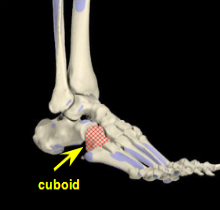The cuboid bone is located in the mid foot just in front of the ankle. This bone acts as a stabilizer that allows you to walk properly and keep your balance when performing activities such as dancing or running. As you put pressure on your feet, this bone is pushed downward to take on the weight of your body, and then it rises again as you lift your foot to make it more comfortable to swing your leg through. Sometimes, stress fracture can occur to the bone.

Causes of a Cuboid Stress Fracture
Repetitive stress on the feet will cause the cuboid to fracture. In most cases this will not shatter the bone, but will cause it to crack. Weight bearing activities such as dancing, jumping or running that are done frequently can put the necessary stress on the feet, causing wear over time that leads to a fracture.
A sudden increase in the level of movement or physical activity can also cause cuboid to fracture as the muscles around the bone will not be built up enough to take on this added amount of activity.
These cracks can become more severe if the strenuous activities that damaged the bone are continued after the damage is done.
Risk Factors of a Cuboid Stress Fracture
Several factors can increase your risk of developing a stress fracture in the cuboid bone.
- Muscle weakness in the feet, gluteals, quadriceps or calves can put more pressure on the feet, increasing your risk of injury.
- Poor foot posture, standing with flat fee or a particularly high arch, can also increase the pressure on the bone, increasing your risk of a stress fracture.
- Those with poor flexibility or joint stiffness in the lower legs, ankles and feet are prone to injury of the bone.
- You may also cause excess stress if you train too often or on inappropriate surfaces such as uneven pavement or very hard surfaces.
- Using poor running technique or wearing inappropriate footwear while you train can also increase your risk of injuring cuboid.
- As with all bone fractures, consuming a diet that does not promote good bone and muscle management increases your risk of injury as well.
Symptoms and Diagnosis of a Cuboid Stress Fracture
Patients will notice localized pain existing in the outer portion of the middle of foot or their ankle as the fracture becomes more pronounced. Performing activities that put pressure on this area of the foot can increase the discomfort associated with this condition. In more severe cases, the pain may also radiate out to the inner portion and the sole of the foot, or through the heel and toes. This pain may be more pronounced at night or when you press on cuboid.
In most cases, a physical examination can detect a fractured cuboid bone. However, many doctors will choose to perform an imaging test including a CT scan, MRI or X-ray to determine the extent of the damage. Some doctors will also require this image confirmation to begin therapy on the affected foot.
Recovery Time of a Cuboid Stress Fracture
In most cases, patients can manage a stress fracture of the bone within 3-6 months. Severe cases may take over a year to heal completely, especially if intervention was not reached early on. Those that do not manage their injury may also see lingering effects throughout their life.
Treatments for a Cuboid Stress Fracture
Treatment for cuboid primarily revolves around resting the foot so it has time to heal.
- Protective Gear - Those with a stress fracture will frequently be given a protective boot or crutches to help them keep their weight off the foot while moving around. The tools needed will vary based on the nature of the injury, as will the amount of time that is required to wear the device.
- Proper Footwear - Orthotics or adjusted running shoes can be used to help correct poor foot posture that is putting pressure on the cuboid bone. Your doctor will perform an examination to help determine what may have contributed to the injury and provide recommendations for different training methods or tools that can help you avoid doing further damage once you are finished with your therapy.
- Hands On Therapy - Massages, dry needling, stretches, electrotherapy or joint mobilization can help the patient relax the foot to bring pressure off of the affected bone. This can also help increase the range of motion in the foot to make it less likely that similar injuries will happen in the future.
- Flexibility Exercises - In addition to seeing a professional to work the injured foot, patients should follow a flexibility routine at home that will increase the range of motion in the foot. Your doctor may provide a list of exercises that should be performed daily to help ensure that the proper range of motion is maintained during the recovery process. However, previous exercise routines such as biking or running should be ceased until the foot has returned back to normal.
